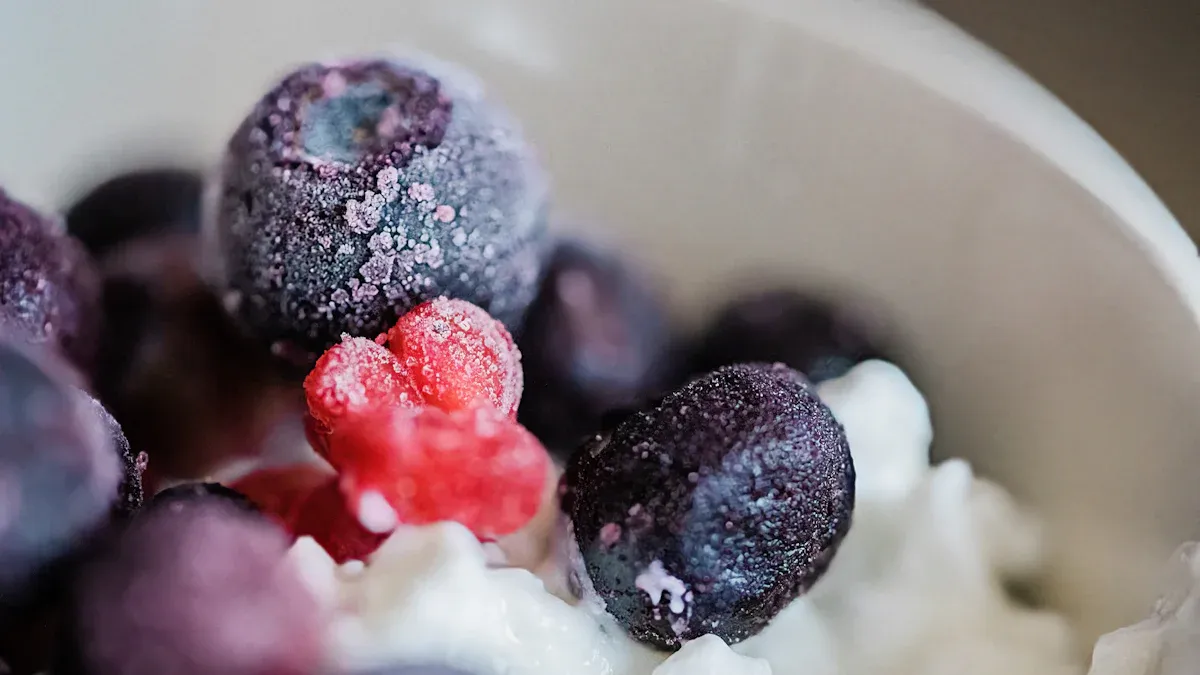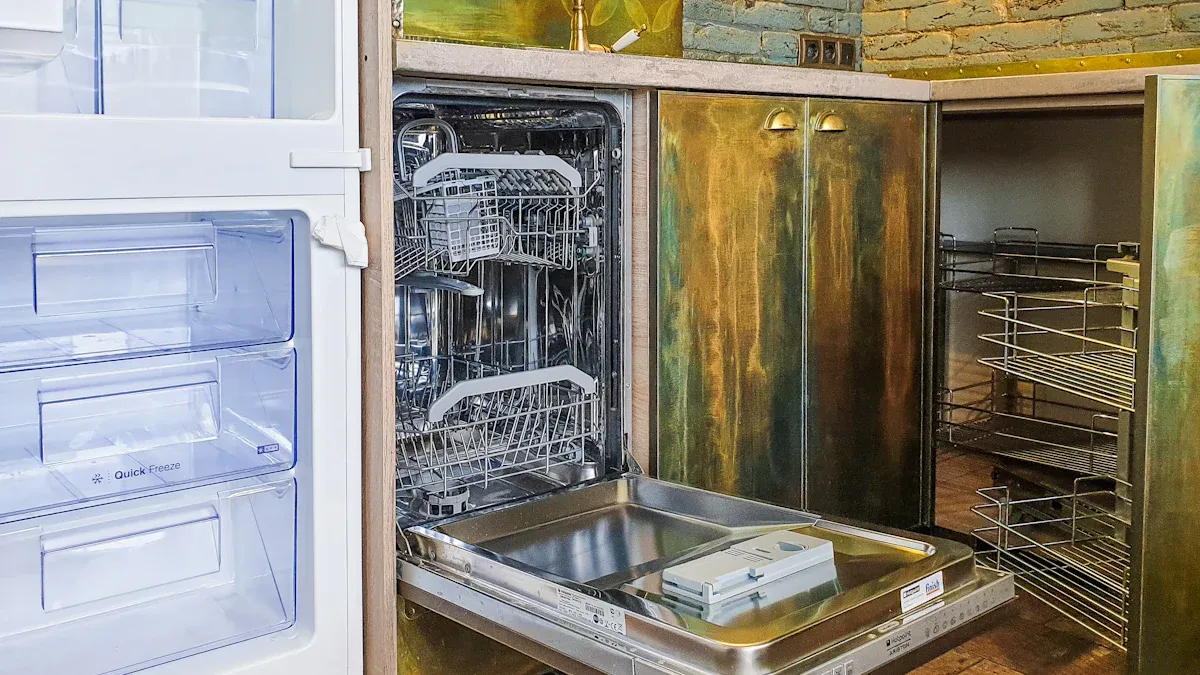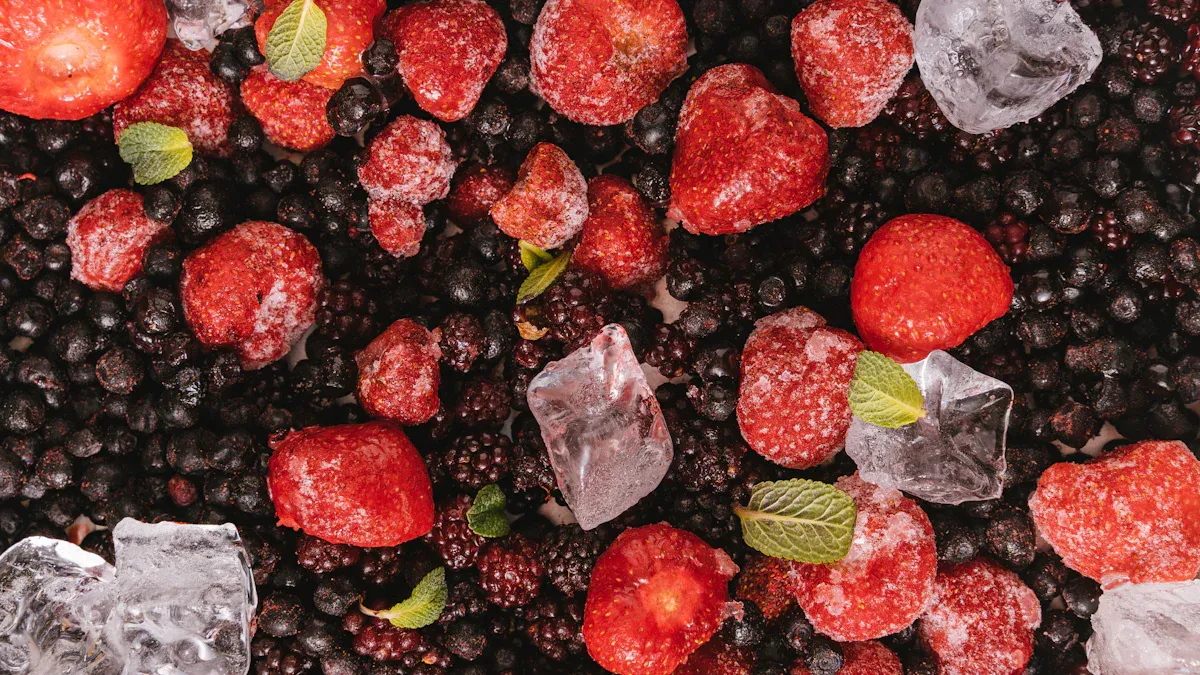Quick Freezer Tips: How to Freeze Food Fast and Fresh

Imagine pulling out bright, juicy tomatoes from your freezer in the middle of winter. The quick freezer makes that possible. You can lock in the flavor of tomatoes and keep their color vibrant. Tomatoes freeze fast with this method, so you get less mush and more taste. Try freezing tomatoes whole, sliced, or diced. Tomatoes love the quick freezer, and you will too. Place tomatoes in your freezer, and see how the quick freezer keeps tomatoes fresh. Tomatoes stay ready for soups, sauces, and salads. Tomatoes never tasted so good straight from your freezer.
Key Takeaways
Use the quick freezer to freeze food faster. Lower the temperature quickly to keep food fresh and tasty.
Get food ready before freezing. Portion food, blanch vegetables, and freeze items in a single layer. This stops food from sticking together.
Freeze tomatoes whole, sliced, or blanched. Choose the way based on how you will use them later. Always use airtight packaging to stop freezer burn.
Freeze egg whites and yolks in separate containers. Take special care to keep their texture. Never freeze eggs in the shell.
Keep your freezer clean and organized to stop freezer burn. Make sure it stays at the right temperature. Thaw frozen food slowly in the fridge for best quality.
Quick Freezer Basics
How Quick Freezer Works
You might wonder what makes a quick freezer different from your regular freezer mode. The answer is all about speed and temperature. When you use the quick freezer or fast freeze function, your freezer drops its temperature much lower than usual. This helps freeze your food much faster. You can activate this feature by pressing and holding the Power Freeze button for three seconds. When it’s on, you’ll see a snowflake icon light up on your freezer’s panel. The quick freezer works hard for up to 50 hours, then goes back to its normal setting.
Here’s a simple table to show the differences:
Feature | Regular Freezer Mode | Power Freeze (Quick Freezer) Function |
|---|---|---|
Temperature Range | 5°F to -8°F (default 0°F) | Drops temperature much lower, very quickly |
Operation | Keeps set temperature | Boosts fan speed, freezes food faster |
Duration | Runs until you change it | Stays on up to 50 hours, then returns to normal |
Energy Usage | Standard | Uses more energy while active |
Activation | Set with controls | Hold Power Freeze button for 3 seconds |
Indicator | Panel light | Snowflake icon lights up |
Tip: Turn on the quick freezer at least 20 hours before adding a lot of food. This helps everything freeze fast and stay fresh.
Why Use Quick Freezer
You want your food to taste as good as the day you bought it. The quick freezer helps you do that. When you freeze food quickly, tiny ice crystals form inside. These small crystals keep the food’s texture, flavor, and nutrients locked in. Slow freezing makes big ice crystals that can damage the food’s structure and make it mushy when thawed.
Scientists have found that rapid freezing creates many nucleation sites. This means more small crystals and less damage to your food. Foods like fruits and vegetables benefit the most. Quick freezing keeps their color bright and their shape perfect. You can even freeze things like peas, berries, and sliced carrots without them sticking together.
If you want your freezer to work its best, keep it organized and don’t overload it. A well-maintained freezer saves energy and keeps your food safe. Remember to check the seals and clean the coils every few months. This way, your quick freezer will always be ready to help you freeze food fast and fresh.
Food Prep for Quick Freezing

Getting your food ready for the quick freezer makes a big difference. You want to keep everything fresh, tasty, and easy to use later. Here’s how you can prep like a pro.
Portioning and Packaging
Start by thinking about how you’ll use your food later. Do you want to grab just a few tomatoes for a salad? Or maybe you want to freeze eggs in small amounts for baking? Portioning helps you avoid waste and makes meal prep simple.
Use vacuum sealers to remove air. This keeps your tomatoes and eggs safe from freezer burn.
Try freezer-safe bags or containers with tight lids. These keep out air and moisture.
Label each package with the date and what’s inside. You’ll always know if you’re grabbing tomatoes, eggs, or something else.
Pack tomatoes in single-use portions. You can grab just what you need for sauces or soups.
Freeze eggs in ice cube trays, then transfer them to airtight bags. This makes it easy to use just one or two eggs at a time.
Tip: Advanced packaging materials help keep your tomatoes and eggs safe from odors and crushing. They also make it easy to freeze eggs in perfect portions.
Blanching Vegetables
Blanching helps your tomatoes and other veggies keep their color and nutrients. It’s a quick step, but it matters.
Boil a big pot of water.
Drop in your tomatoes or other veggies for just a few minutes. For carrots, try 2 to 3 minutes.
Move them right into ice water to stop the cooking.
If you skip blanching, your tomatoes might lose flavor or turn mushy. The same goes for other veggies. Always follow the right time for each vegetable.
Arranging Food in a Single Layer
When you freeze tomatoes, eggs, or any food, spread them out in a single layer first. This helps everything freeze fast and evenly.
Lay tomatoes slices or diced pieces on a tray. Do the same for eggs if you’re freezing them in cubes.
Once frozen solid, move them into airtight containers or bags.
Don’t overload your freezer. Cold air needs to move around your tomatoes and eggs.
Keep the freezer door closed as much as possible. This keeps the temperature steady and helps your food freeze fast.
Tip: Freezing in a single layer stops tomatoes and eggs from sticking together. You can grab just what you need, every time.
With these tips, you’ll keep your tomatoes and eggs fresh, tasty, and ready for anything. Quick freezer prep saves time and keeps your food at its best.
How to Freeze Tomatoes and More

How to Freeze Tomatoes
You want to know how to freeze tomatoes the right way. You have a few options, and each one works well for different recipes. Let’s walk through the steps so you can keep your tomatoes fresh and tasty all year.
Wash your tomatoes under cold water. Pat them dry with a clean towel.
If you want to freeze tomatoes whole, place each tomato on a baking sheet. Make sure they do not touch. Put the tray in your quick freezer for 2 to 4 hours. When the tomatoes are solid, move them to freezer bags or containers. This stops them from sticking together.
For freezing tomatoes sliced or chopped, wash and dry them first. You can peel them if you want. Spread the pieces on a tray in a single layer. Freeze until solid, then pack them into bags.
If you want to freeze tomatoes pre-blanched, start by scoring a small “X” at the base of each tomato. Drop them in boiling water for 30 seconds. Move them to ice water right away. This makes peeling easy and keeps the color bright. Blanching also helps keep the flavor and texture after thawing. It slows down enzymes that can make tomatoes mushy or dull.
For freezing blended tomatoes, wash and peel them first. Blend to your favorite texture. Let the puree cool. Pour it into ice cube trays or portioned bags. Remove as much air as you can before sealing.
Always use freezer bags or containers. Squeeze out extra air. Lay bags flat in your freezer. This saves space and helps everything freeze fast.
Tip: Frozen tomatoes lose their fresh texture, so use them in cooked dishes like soups or sauces. You can grate or chop frozen tomatoes right from the freezer without thawing.
Here’s a quick table to help you choose the best method:
Method | Best For | Prep Steps |
|---|---|---|
Freeze tomatoes whole | Stews, sauces | Wash, dry, freeze on tray, bag when solid |
Freezing tomatoes sliced | Stir-fries, quick meals | Wash, slice, freeze on tray, bag when solid |
Freeze tomatoes pre-blanched | Soups, sauces | Score, blanch, peel, freeze, bag |
Freezing blended tomatoes | Smooth sauces, soups | Wash, blend, cool, freeze in trays or bags |
You now know how to freeze tomatoes in every way. Try each method and see which one you like best.
Freeze Egg Whites
You can freeze egg whites with great results. This is perfect if you bake a lot or want to save extra eggs. Here’s how you do it:
Crack your eggs and separate the whites from the yolks. Make sure no yolk gets into the whites.
Pour the egg whites into a clean ice cube tray. Each cube holds about one egg white.
Freeze the tray until the whites are solid. Pop them out and store in a freezer-safe bag or container.
Label the bag with the date and number of egg whites.
When you want to use them, thaw the egg whites in the fridge overnight. They whip up just like fresh ones. You can use them for meringues, omelets, or baking. Freezing egg whites keeps their texture smooth and light.
Note: Do not freeze eggs in the shell. Always separate before freezing.
Freeze Egg Yolks
Egg yolks need a little extra care when you freeze them. If you freeze yolks by themselves, they can get thick and hard to use. Here’s a simple way to keep them smooth:
Separate the yolks from the whites. Place the yolks in a small bowl.
Add a pinch of salt or sugar to the yolks. Use salt if you plan to use them in savory dishes, or sugar for desserts. This keeps the yolks from turning gummy.
Beat the yolks gently to mix in the salt or sugar.
Pour the yolks into a freezer-safe container. Label with the date and note if you used salt or sugar.
When you want to use the yolks, thaw them in the fridge. They work well in custards, sauces, or scrambled eggs. You can freeze eggs in parts and always have what you need for any recipe.
Tip: Freezing whole eggs does not work well. The shells can crack, and the texture changes. Always separate before freezing.
You now know how to freeze eggs in every way. Try freezing egg whites and yolks separately for the best results. You will always have eggs ready for baking or cooking.
Troubleshooting and Tips
Preventing Freezer Burn
Freezer burn can sneak up on your tomatoes and other foods if you are not careful. You might notice dry spots or a strange texture after you pull tomatoes from the freezer. This happens when air gets to your food and ice crystals form. Tomatoes with freezer burn lose their bright color and taste dull. The texture can turn rubbery or dry, which is not what you want for your tomatoes.
Here are some common causes of freezer burn and how you can stop it:
Damaged or loose door seals let warm air inside your freezer.
Opening the freezer door too often or for too long lets in moisture.
Placing hot tomatoes or other foods straight into the freezer adds extra moisture.
Incorrect temperature settings make it hard for your freezer to keep things cold enough.
Overloading the freezer blocks air from moving around your tomatoes.
Faulty defrost systems or clogged drains can cause frost to build up.
Tip: Always cool tomatoes before freezing. Use freezer-safe bags or containers and squeeze out as much air as you can. Keep your freezer at 0°F for best results.
You should check the door seals and clean the freezer regularly. Try to keep your freezer about two-thirds full so air can move around your tomatoes. If you see frost building up, defrost your freezer when it gets about a quarter-inch thick.
Thawing for Best Quality
When you want to use your tomatoes, you need to thaw them the right way. If you rush, you might end up with mushy tomatoes or lose flavor. The best way to thaw tomatoes is to move them from the freezer to the fridge. This slow process keeps the texture and taste as close to fresh as possible.
If you need tomatoes for soups or sauces, you can use them straight from the freezer. For salads, let tomatoes thaw in the fridge overnight. Avoid thawing tomatoes on the counter, as this can make them soggy.
When it comes to defrosting frozen eggs, always thaw them in the fridge. This keeps the texture smooth and safe to eat. Never use a microwave for defrosting frozen eggs or tomatoes, as this can change the texture and taste.
Tip: Organize your freezer so you can find tomatoes and other foods quickly. Label everything with dates. This helps you use the oldest tomatoes first and avoid waste.
If you plan to freeze a lot of tomatoes, switch your freezer to quick freeze mode ahead of time. Once your tomatoes are frozen solid, you can switch back to regular mode to save energy.
A little planning and these tips will keep your tomatoes tasting great and your freezer running smoothly.
You now know how to freeze tomatoes fast and keep them fresh. Start by prepping tomatoes, using the quick freezer, and storing them right. Remember, tomatoes freeze best when you avoid common mistakes. Here’s a quick checklist for success:
Keep tomatoes in airtight containers.
Don’t open the freezer door too much or tomatoes may get frost.
Clean the freezer with mild soap, not bleach, to protect tomatoes.
Wipe up any condensation so tomatoes stay dry.
Check that nothing blocks the door so tomatoes freeze well.
Try these tips and enjoy tomatoes all year. Got your own quick freezer tricks for tomatoes? Share your questions or ideas below!
FAQ
How long can you keep food in the quick freezer?
You can keep most foods in the quick freezer for up to 3 months. After that, the flavor and texture may change. Always label your packages with the date so you know when to use them.
Can you refreeze food after thawing it?
It’s best not to refreeze thawed food. Refreezing can change the texture and may cause freezer burn. If you must refreeze, make sure the food stayed cold and safe the whole time.
Why do my frozen tomatoes look watery after thawing?
Tomatoes have a lot of water. When you freeze and thaw them, some water comes out. This is normal. Use thawed tomatoes in cooked dishes like soups or sauces for the best results.
What foods should you avoid freezing in a quick freezer?
Lettuce
Cream-based sauces
Fried foods
These foods do not freeze well. They can turn mushy or separate after thawing. Stick to fruits, vegetables, and cooked meats for the best results.
See Also
How To Effectively Use Quick Freeze Compressors In Food Production
Essential Tips To Keep Your Plate Freezer Running Smoothly
IQF Tunnel Freezers Revolutionizing Modern Food Storage Solutions
The Impact Of Quick Freeze Tunnels On Food Industry Innovation

